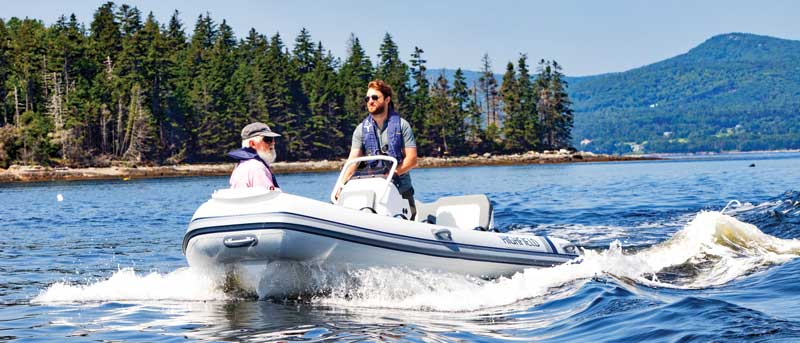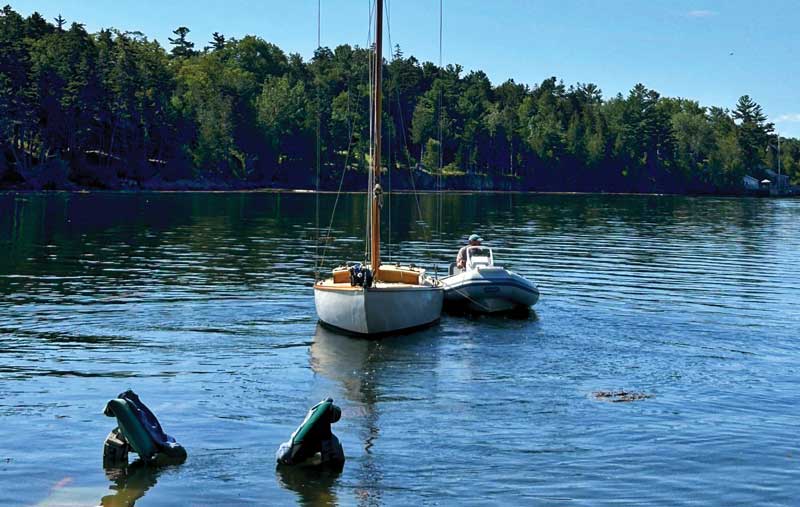Take Charge: An electric boat for commercial use
 Pendleton Yacht Yard on Islesboro has been using Take Charge, a rib outfitted with a 40-hp electric outboard, as a yard workboat as part of a demonstration project on the potential for electric propulsion for commercial marine uses. Photo by Jack Sullivan/Island Institute
Pendleton Yacht Yard on Islesboro has been using Take Charge, a rib outfitted with a 40-hp electric outboard, as a yard workboat as part of a demonstration project on the potential for electric propulsion for commercial marine uses. Photo by Jack Sullivan/Island Institute
The new workboat at Pendleton Yacht Yard on Islesboro doesn’t stand out as being different. But looks can be deceiving. Take Charge, a 13-foot rib powered by a 40-hp electric motor, is part of a ground-breaking project to bring electric propulsion to the commercial marine industry.
Since late last spring, Gabe Pendleton and his crew at the yard have been using the new boat for service calls, moving marine equipment and materials, and other working waterfront needs, all the while collecting data on its performance as part of a project spearheaded by the nonprofit Island Institute.
The benefits of electric outboard motors include significantly reduced Co2 emissions (even when charged with non-renewable energy sources), less water pollution, more predictable operating costs and quiet operation, according to Lia Morris, the institute’s community development officer.
She said the Pendleton demonstration project is part of a three-year initiative, funded in part by a $500,000 Maine Technology Institute grant, to electrify the working waterfront. The project has three parts: workforce development, which includes training mechanics to install and maintain electric motors; assessing the infrastructure needs, including how to fill the gaps in placing charging stations along the coast and understanding where fast-charging is needed; and demonstrating the potential for electric-powered workboats by putting them in places like PYY.
“We are trying to keep our finger on the pulse of all different aspects from hull manufacture, to shore-side charging, to motors,” Morris said.
 The electric-powered workboat has proven to be an economical workhorse, according to Gabe Pendleton. Photo courtesy Pendleton Yacht Yard
The electric-powered workboat has proven to be an economical workhorse, according to Gabe Pendleton. Photo courtesy Pendleton Yacht Yard
A web-based introductory course on electric boats already is in place, offered in conjunction with the Maine Community College System, the Mid-Coast School of Technology, and Maine Electric Boat Company. And a follow-up course on electric outboard maintenance is in the works, Morris said.
“We want the sector to take hold for commercial application of boats in Maine,” she said. “That requires a workforce that knows how to work on electric motors.”
PYY was chosen for the demonstration because the yard already had taken significant steps to reduce its fossil fuel use, installing solar panels and purchasing three electric-powered vehicles, Morris said.
In addition to the workboat, Pendleton said he is exploring options for an electric-powered water taxi to carry passengers between Islesboro and the mainland. The yard also has repowered a number of sailboats with electric motors, including a Herreshoff 12½.
“We really want to push the envelope in terms of trying new technology and seeing if it can be used for others,” Pendleton said.
Take Charge, a Classic 420 Highfield RIB outfitted with a motor made by Flux Marine, was sourced through Maine Electric Boat Co. The Rhode Island-based Flux also provided the boat’s 24-kilowatt-hour lithium battery, which is installed in the console. A separate 12-volt battery in the bow powers a data-collection system tracking Take Charge’s performance to inform future improvements.
 The island-based yard stores many Dark Harbor 20s, including this one being brought to the haulout ramp by Take Charge, Pendleton Yacht Yard’s electic-powered workboat. Photo courtesy Pendleton Yacht Yard
The island-based yard stores many Dark Harbor 20s, including this one being brought to the haulout ramp by Take Charge, Pendleton Yacht Yard’s electic-powered workboat. Photo courtesy Pendleton Yacht Yard
Take Charge, which can travel up to 20 nautical miles wide open, has proven to be economical and efficient, Pendleton said. The boat’s batteries can recharge overnight on a conventional household outlet, and in just four hours on a fast charger. The electric motor requires far less maintenance than a traditional gas-powered outboard, he said. There are no issues with low-quality gas, sparkplugs and oil that need changing, or carburetors requiring a rebuild. All that’s needed to winterize the motor is turning it off.
“The reduced time you need to spend working on things is nice,” he said. “The lack of down time of dealing with a broken-down work boat might be the most powerful rationale for making the switch.” Plus, the motor is very quiet.
There have been a few technical issues, Pendleton noted. For example, the battery light will indicate that it is charged when it’s not, if the key was in the ignition during charging. In addition, the shifting process works differently than in a conventional gas outboard. Shifting into forward can put the boat instantly at full speed, which can be startling, compared to the gradual increase of a conventional engine throttle, he said.
“Part of what we are doing with Island Institute is providing intentional feedback about the boat,” Pendleton said. “I suspect the next iteration of outboards they [Flux] put out will be better. It’s a learning process in terms of getting things dialed in to whatever can work on a larger scale.”
Pendleton noted that the full package—boat and motor—costs roughly $35,000, which he estimates is not much more than the cost of a RIB with a conventional engine.
Based at Rumery’s Boat Yard, in Biddeford, Maine Electric Boat offers electric boat rentals and sales, and is the sole dealer for Flux in Maine. Matt Tarpey, the company’s co-founder and president, said electric motors up to now have been much more prevalent in recreational boats than commercial. “The goal with this project,” he said, “was to make sure everything is running smoothly in one of the first true commercial electric boats in the country.”
The Flux motor on Pendleton’s RIB is in the early stages of manufacturing and not yet available for wide-spread purchase, Tarpey said, adding that plans call for ramping up production of the 40-hp motor in 2024.
Currently, electric motors work well on smaller boats with motors under 100 hp, he explained. But the larger the motor, the more expensive the battery pack, which remains a barrier to introducing the technology to commercial fishing vessels. The long-term goal, he and Morris agreed, is to figure out how to make electric motors economical for these bigger commercial boats.
“The only thing holding us back is storage technology,” Tarpey said.
In addition to Take Charge, the Institute has awarded the Apprenticeshop in Rockland a grant to install an Elco motor on a runabout used in its sailing program. Another grant to Maine Audubon will help to retrofit a pontoon boat over the winter, also with an Elco.
✮
Polly Saltonstall is Editor at Large of Maine Boats, Homes & Harbors.
TAKE CHARGE Specifications
LOA: 13'10"
Internal length: 10'5"
Overall width: 6'11"
Internal width: 3'5"
Weight: 883 lbs. rigged
Max load: 1,814 lbs.
Engine: 40-hp Flux Marine Outboard
Builder:
Highfield Boats
www.highfieldboats.com
Distributor:
Maine Electric Boat Co.
109 Cleaves St., Biddeford, ME
www.maineelectricboat.com
Related Articles
Share this article:
2023 Maine Boat & Home Show

Join Us for the Maine Boat & Home Show!
Art, Artisans, Food, Fun & Boats, Boats, Boats
August 11 - 13, 2023 | On the waterfront, Rockland, Maine
Click here to pre-order your tickets.
Show is produced by Maine Boats, Homes & Harbors magazine.















